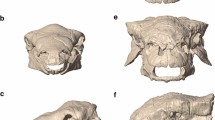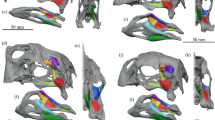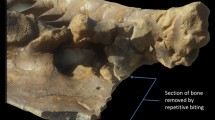Abstract
Sauropod dinosaurs were the largest terrestrial herbivores and pushed at the limits of vertebrate biomechanics and physiology. Sauropods exhibit high craniodental diversity in ecosystems where numerous species co-existed, leading to the hypothesis that this biodiversity is linked to niche subdivision driven by ecological specialisation. Here, we quantitatively investigate feeding behaviour hypotheses for the iconic sauropod Diplodocus. Biomechanical modelling, using finite element analysis, was used to examine the performance of the Diplodocus skull. Three feeding behaviours were modelled: muscle-driven static biting, branch stripping and bark stripping. The skull was found to be ‘over engineered’ for static biting, overall experiencing low stress with only the dentition enduring high stress. When branch stripping, the skull, similarly, is under low stress, with little appreciable difference between those models. When simulated for bark stripping, the skull experiences far greater stresses, especially in the teeth and at the jaw joint. Therefore, we refute the bark-stripping hypothesis, while the hypotheses of branch stripping and/or precision biting are both consistent with our findings, showing that branch stripping is a biomechanically plausible feeding behaviour for diplodocids. Interestingly, in all simulations, peak stress is observed in the premaxillary–maxillary ‘lateral plates’, supporting the hypothesis that these structures evolved to dissipate stress induced while feeding. These results lead us to conclude that the aberrant craniodental form of Diplodocus was adapted for food procurement rather than resisting high bite forces.


Similar content being viewed by others
References
Bakker RT (1986) The dinosaur heresies. Avon, Bath
Barrett PM, Upchurch P (1994) Feeding mechanisms of Diplodocus. Gaia 10:195–203
Calvo JO (1994) Jaw mechanics in sauropod dinosaurs. Gaia 10:183–193
Cattaneo PM, Dalstra M, Melsen B (2005) The finite element method: a tool to study orthodontic tooth movement. J Dent Res 84:428–433
Christiansen P (2000) Feeding mechanisms of the sauropod dinosaurs Brachiosaurus, Camarasaurus, Diplodocus, and Dicraeosaurus. Hist Bio 14:137–152
Chure D, Britt BB, Whitlock JA, Wilson JA (2010) First complete sauropod dinosaur skull from the Cretaceous of the Americas and the evolution of sauropod dentition. Naturwissenschaften 97:379–391
Coombs WP Jr (1975) Sauropod habits and habitats. Palaeogeog, Palaeoclimatol, Palaeoecol 17:1–33
Curry KA (1999) Ontogenetic histology of Apatosaurus (Dinosauria: Sauropoda): new insights on growth rates and longevity. J Vertebr Paleontol 19:654–665
Dumont E, Piccirillo J, Grosse I (2005) Finite-element analysis of biting behavior and bone stress in the facial skeletons of bats. Anat Rec 283:319–330
Gröning F, Fagan MJ, O’Higgins P (2011) The effects of the periodontal ligament on mandibular stiffness: a study combining finite element analysis and geometric morphometrics. J Biomech 44:1304–1312
Holland WJ (1906) The osteology of Diplodocus Marsh. Mem Carnegie Mus 2:225–278
Holland WJ (1910) A review of some recent criticisms of the restorations of sauropod dinosaurs existing in the museums of the United States, with special reference to that of Diplodocus carnegiei in the Carnegie Museum. Am Nat 44:259–283
Holland WJ (1924) The skull of Diplodocus. Mem Carnegie Mus 9:379–403
Holliday CM (2009) New insights into dinosaur jaw muscle anatomy. Anat Rec A 292:1246–1265
Holliday CM, Witmer LM (2008) Cranial kinesis in dinosaurs: intracranial joints, protractor muscles, and their significance for cranial evolution and function in diapsids. J Vertebr Paleontol 28:1073–1088
Mannion PD, Upchurch P, Carrano MT, Barrett PM (2011) Testing the effect of the rock record on diversity: a multidisciplinary approach to elucidating the generic richness of sauropodomorph dinosaurs through time. Biol Rev 86:157–181
Nalla RK, Kinney JH, Ritchie RO (2003) Mechanistic failure criteria for the failure of human cortical bone. Nat Mater 2:164–168
Niklas KJ (1992) Plant biomechanics. University of Chicago, Chicago
Panagiotopoulou O, Kupczik K, Cobb SN (2011) The mechanical function of the periodontal ligament in the macaque mandible: a validation and sensitivity study using finite element analysis. J Anat 218:75–86
Rayfield EJ (2007) Finite element analysis and understanding the biomechanics and evolution of living and fossil organisms. Annu Rev Earth Planet Sci 35:541–576
Rayfield EJ, Norman DB, Horner CC, Horner JR, Smith PM, Thomason JJ, Upchurch P (2001) Cranial design and function in a large theropod dinosaur. Nature 409:1033–1037
Richmond B, Wright B, Grosse I, Dechow P, Ross C, Spencer M, Strait D (2005) Finite element analysis in functional morphology. Anat Rec A 283:259–274
Sereno PC, Wilson JA, Witmer LM, Whitlock JA, Maga A, Ide O, Rowe TA (2007) Structural extremes in a Cretaceous dinosaur. PLoS One 2:e1230
Toms SR, Eberhardt AW (2003) A nonlinear finite element analysis of the periodontal ligament under orthodontic tooth loading. Am J Orthod Dentofac Orthop 123:657–665
Tornier G (1911) Bau und Lebensweise des Diplodokus [sic]. Bericht der Senckenbergischen Naturforschenden Gesellschaft 42:112–114
Upchurch P (1995) The evolutionary history of sauropod dinosaurs. Phil Trans R Soc Lond B 349:365–390
Upchurch P, Barrett PM (2000) The evolution of sauropod feeding mechanisms. In: Sues H-D (ed) Evolution of herbivory in terrestrial vertebrates: perspectives from the fossil record. Cambridge University, Cambridge, pp 79–122
Upchurch P, Barrett PM, Dodson P (2004) Sauropoda. In: Weishampel DB, Dodson P, Osmólska H (eds) The dinosauria, 2nd edn. University of California, Berkeley, pp 259–322
Whitlock JA (2011) Inferences of diplodocoid (Sauropoda: Dinosauria) feeding behavior from snout shape and microwear analysis. PLoS One 6:e18304
Wilson JA, Sereno PC (1998) Early evolution and higher-level phylogeny of sauropod dinosaurs. Soc Vertebr Paleontol Mem 5:1–68
Witzel U, Mannhardt J, Goessling R, De Micheli P, Preuschoft H (2011) Finite element analyses and virtual syntheses of biological structures and their application to sauropod skulls. In: Klein N, Remes K, Gee CT, Sander PM (eds) Biology of the sauropod dinosaurs: understanding the life of giants. Indiana University, Bloomington, pp 171–181
Acknowledgments
We thank Clint Davies-Taylor and Neil Gostling for their computing assistance, Karl Niklas and Steven Vogel for their discussion on plant biomechanics, Mike Brett-Surman and Amy Henrici for specimen access, Heather Rockhold for CT scanning and John Whitlock and an anonymous reviewer for their comments on a previous version of this article. We gratefully acknowledge the financial support of the Natural Environment Research Council (NER/S/A/2006/14058) and the Natural History Museum London (awarded to EJR and PMB) and the National Science Foundation (IBN-0407735 to LMW and CMH, and IBN-0343744 and IOB-0517256 to LMW).
Author information
Authors and Affiliations
Corresponding author
Additional information
Communicated by: Robert Reisz
Electronic supplementary material
Below is the link to the electronic supplementary material.
ESM 1
(DOCX 10 mb)
Rights and permissions
About this article
Cite this article
Young, M.T., Rayfield, E.J., Holliday, C.M. et al. Cranial biomechanics of Diplodocus (Dinosauria, Sauropoda): testing hypotheses of feeding behaviour in an extinct megaherbivore. Naturwissenschaften 99, 637–643 (2012). https://doi.org/10.1007/s00114-012-0944-y
Received:
Revised:
Accepted:
Published:
Issue Date:
DOI: https://doi.org/10.1007/s00114-012-0944-y




